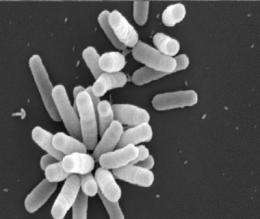Bacterial plasmids -- the freeloading and the heavy-lifters -- balance the high price of disease

Studying self-replicating genetic units, called plasmids, found in one of the world's widest-ranging pathogenic soil bacteria -- the crown-gall-disease-causing microorganism Agrobacterium tumefaciens -- Indiana University biologists are showing how freeloading, mutant derivatives of these plasmids benefit while the virulent, disease-causing plasmids do the heavy-lifting of initiating infection in plant hosts. The research confirms that the ability of bacteria to cause disease comes at a significant cost that is only counterbalanced by the benefits they experience from infected host organisms.
A. tumefaciens is widely studied for its remarkable biology not only because it causes disease in over 140 genera of broadleaf plants, including fruit trees, grapes, roses and walnut trees, but also because it is considered one of the most important tools for plant biotechnology: It is the only organism known to routinely engage in inter-kingdom lateral gene transfer. A. tumefaciens infects host plants by transferring a portion of its own DNA into plant cells, and this integrated bacterial DNA is expressed in the plant cells, leading diseased plants to develop tumors and produce resources that benefit the pathogen.
"We've identified two types of costs the plant pathogen A. tumefaciens pays for traits conferred by genes carried on plasmids," said lead author Thomas G. Platt, a postdoctoral researcher in the IU Bloomington College of Arts and Sciences' Department of Biology. "There is a relatively low cost of maintaining the tumor-inducing virulence plasmid, but there is also a dramatically large cost of expressing the genes that are required to infect plants."

Plants with crown gall disease can also benefit a second type of plasmid that can be found in A. tumefaciens: Nonpathogenic plasmids that lack the genes required to infect plants, yet are still able to benefit from the breakdown of nutrient resources released by infected plant tissue.
"These nonvirulent strains are able to freeload on public goods produced by host plants infected by their disease-causing relatives, while themselves avoiding the burdens associated with A. tumefaciens' virulence plasmid," Platt explained. "And our results suggest that at least one source of the selective pressure favoring the spread of these avirulent mutants stems from those high costs associated with the expression of the genes underlying pathogenesis."
Scientists are especially interested in freeloading or cheating strains of bacteria as a possible means of constraining infection caused by more aggressive, pathogenic strains. Creating something of a balancing act, mutant cheater strains may counter or constrain virulence as they maintain higher fitness by not having to invest in the cellular machinery virulent bacteria employ to infect hosts.
"The population dynamics and maintenance of bacterial plasmids depend on the costs they impose and benefits they confer on the cells that host them, and those costs and benefits are environmentally context dependent," Platt said. "The outcome of competition between two agrobacteria strains such as the ones we have been studying varies with the environmental conditions in which they are competing, and this genotype-by-genotype-by-environment interaction suggests that the virulence plasmid may be subject to selective pressures that vary over space and time."
Provided by Indiana University
















